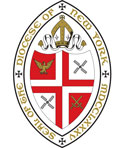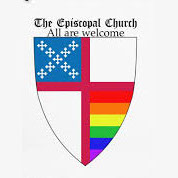Podcast: Play in new window | Download (Duration: 16:14 — 15.3MB)
Subscribe: Apple Podcasts | RSS
The Seventh Sunday of Easter
Watch the sermon here.
Acts 1:15-17, 21-26
1 John 5:9-13
John 17:6-19
Psalm 1
And all of these churches are founded on one belief: that Jesus is the Son of God, and our Savior. That is basically it, when you boil it all down. A Christian is a person whose belief in God is centered in the saving work of Jesus Christ.
And while this saving work is often connected to the afterlife, closer attention to the heartfelt, loving prayer Jesus prays in what’s known as the farewell discourse reveals what that saving work is meant to be: knowing God, and more specifically, knowing God through Jesus. 2 billion people in the world spread over hundreds or thousands of churches all believe in a God who gives us the opportunity to experience eternal life starting right now – by knowing God, and knowing Jesus. By having a relationship with your creator, and embracing the saving work of Jesus in your life. It seems like an easy common ground for all Christians to have, a message that can cross all sorts of cultural, socio-economic, racial, and gender boundaries.
So how can a message that has the potential to be so unifying be so divisive?
The church is fractured over scores of theological disagreements – the divinity and humanity of Jesus, how to define the Trinity, when and how many times one can be baptized, whether Communion really is the body and blood of Christ or merely a symbol of his sacrifice, how the Bible should be interpreted, the authority of Scripture and Tradition, adhering to a common statement of faith… these arguments and so many more have divided the church over and over again throughout its history. And these divisions are only made worse by disagreements over the church’s response to social issues – poverty, homelessness, hunger, addiction, racism, sexism, classism, recovery from natural disasters, human trafficking, the environment and our stewardship of the earth, and of course the two hot topics our public discourse can’t seem to get enough of, abortion and LGBTQ+ issues.
To make matters more complicated, these divisions over theological and social issues are only part of the equation. Because Christianity exists today across cultures and continents, the church has a multitude of languages and cultures and expressions. While this started out as a way for the message of the gospel to reach to the ends of the earth, with the church speaking the language of the people, it has also blurred the lines between house of worship and community center. (And trust me, growing up in an ethnic church, I can say that with some authority.) The more a church develops its sense of cultural identity, whatever that culture is based on, the more it builds up walls around itself, walls as strong as the ones erected by theological and social differences. In short, the church has splintered over theological, social, and cultural differences, making any sort of reconciliation and labor toward unity an extremely daunting, nearly impossible, task.
And yet, in today’s Gospel, that is the heart of Jesus’ prayer. “Father, may they be one, as you and I are one.” Unlike the synoptic gospels of Matthew, Mark, and Luke, John’s gospel has a different kind of Lord’s prayer. There is no “Lord, teach us to pray,” no words of Jesus that are repeated by his followers in their own prayer lives. This Lord’s prayer, this prayer of Jesus, in the gospel of John, is known as the Farewell Discourse, and it is a prayer of love, care, and protection. I know a lot of people like to point to John 3:16 as the summation of God’s love for us, but I can’t think of anywhere else in Scripture where we can feel Jesus’ love for us more than in the Farewell Discourse. He prays that his disciples – then and now – would belong to God as they belong to him, and that they would be preserved and protected from the evil one. That we would not succumb to the temptations of this world, but grow in love to form a new kind of community, where God’s reign is supreme. Where love conquers fear. Where there is a unity of souls bound together in God. The kind of unity the church has the potential to be capable of.
The church struggles to remember that unity is not the same as uniformity. Churches are among the most homogenous institutions in the world today. Despite Jesus’ command to “Go and make disciples of all nations,” despite our belief that “in Christ there is no Jew or Greek, slave or free, male and female, but we are all one in Christ Jesus,” churches still struggle to be truly welcoming to all who enter their doors. According to the Hartford Insitute of Religion Research, “11:00 Sunday morning continues to be the most segregated hour in America.” There now exists a host of books, conferences, seminars, and retreats for churches on how to be more multi-cultural. Yet what does it truly mean to be a mutli-cultural church? Can a congregation that is primarily White Anglo-Saxon with its own cultural customs entrenched in its church life – tablecloths that must go to the floor, using good china at church functions, making sure the napkins are the right color – truly include a Hispanic church who couldn’t care less about the plastic plates but cares a great deal about who made the pupusas and rice and beans? Would a Black charismatic church be able to stand alongside a Korean congregation in worship and fellowship? Would the leftover kimchee in the fridge make the collard greens taste funny? Could a Mainline Protestant worship with an evangelical, non- denominational church, or would it be too difficult to have praise bands and organ music exist in the same worship space? Could a Roman Catholic who believes that the Eucharist is truly the body and blood of Christ worship with a Baptist who sees the bread and wine as mere symbols? Could a Greek Orthodox church handle the Pentecostals speaking in tongues, as they struggle to worship in beloved Greek?
The thing about unity is that our desire to “be one” with Christians who differ from us wanes when we don’t know what our community will look like if the walls that divide us start coming down. The possibility that we might look different, that we might change, that “the other” might threaten what we perceive as our identity becomes the stumbling block to real unity.
Whether that is a different stance on a social issue, or a different approach to interpreting the Bible, or a different style of prayer and worship, or a different group of people coming through the doors, our differences can hold us back from movement toward unity. Differences are threatening – they threaten our identity. When we truly consider unity in the church, when we truly pray that we all may be one, we are also asking what it is of ourselves we must set aside. Our egos, our sense of identity, all become fragile and potentially bruised when we come face to face with those who differ from us.
Differences can’t be ignored. To do so would be foolish and naïve at best. But we also can’t let them get in the way. To place a higher priority on what separates us than what unites us as Christians is to make a false idol out of our own beliefs and customs. To assume we must protect ourselves from differences is to allow fear to conquer love. Yet the Scriptures say that perfect love casts out fear.
Can you imagine the unity of a church that did not live in fear, but celebrated and honored the uniqueness that God created in each one of us?
Jesus prayed for God’s protection over his followers, so that they may be one. We need God to protect us from our fear if we are to work toward unity. Otherwise, we risk shielding ourselves from the richness of God’s kingdom that exists on the other side of the walls we have built. The church needs eternal life now – to know God, and know Jesus, and thus to know the other as neighbor. And the church needs to shield the world from the lie that makes enemies out of differences, as it bravely steps forward in love.
Let us pray.
O God, you made us in your own image and redeemed us through Jesus your Son: Look with compassion on the whole human family; take away
the arrogance and hatred which infect our hearts; break down the walls that separate us;
unite us in bonds of love; and work through our struggle and confusion to accomplish your purposes on earth; that, in your good time, all nations and races may serve you in
harmony around your heavenly throne; through Jesus Christ
our Lord. Amen.
*Numbers from Pew Research Forum, the Center for the Study of Global Christianity at Gordon-Conwell Theological Seminary, and the Hartford Institute for Religion Research




